April 18th: Triana and the Feria de Abril
The first sight of the day out on the street was a grandpa, stretched out on a park bench deeply asleep and guarded by his three rat dogs, all on leashes but free, guarding him in his slumber. What a perfect sight to begin another day.
Following a recommendation from our Frommer’s Guide, we crossed the river and walked through the Triana district, home to Sevilla’s ceramic tile industry. An early flotilla of sculls and racing canoes was out on the river, gliding through the early morning light. Each day we’ve been here, we’ve seen people out either peacefully plying the smooth water or really putting themselves into a quick transit. I’m always so envious, and seeing them makes me wish that was something we could partake in. But given where we live, it’s not to be.
Our book suggested that some of the tile workshops would be open, none were but it was a nice walk and many of the building fronts were decorated in the tile work we’ve come to love. We made a quick stop in the Capillia de los Marineros, the Sailor’s Chapel, built between 1759 and 1815 and the last stop for sailors heading out across the Atlantic for the New World during the height of Spain’s colonization. The Virgin of Hope graces the main altar and a very beautiful altar with a highly detailed depiction of Christ and the Cross graces a side chapel. An elderly woman, in for morning prayers motioned me over to make sure that I would not leave without seeing it.
The Iglesia de Santa Ana was just up the street so we stopped by, paying a bargain price of 3 € for entry and receiving a nice laminated guide in English. The church was founded in 1264 by King Alfonso X after he had finished re-claiming Sevilla from the Moors. He named it for Saint Anne, the mother of the Virgin and in thanks for her intercession in curing him of a plague that hit the city around that time. It was a nice church, but what made our stop special was Manuel, the church docent who asked us if we’d like a personal tour of the crypt. Gathering up an Austrian couple, the only other visitors, he led us to a door behind a side chapel and down a windy set of stairs into the very foundation of the church, down where the brick work dated to the original construction on the 13th century. He was very proud and unusually tolerant of our meager Spanish, taking the time to explain all the pieces of ritual silver, much of it made from material brought back from Pizarro’s conquering of the Incas. He stopped at each case, giving us the details and stories behind the items, most of which dated to the 16th century. In a side alcove we stopped to look at a beautifully carved bust of Saint Ursula, home a a fragment of her skull and dating to the late 1300s.
As we got to know him, we talked a bit about where we were from and our village’s patron, San Ysidro and the old church around the corner from our home. It turned out that Manuel was a retired engineer from Siemens and he was most excited to learn that I was retired from Intel. Brothers in technology as it were. After the crypt he walked with us, fleshing out the details about the other chapels, the altar and the organ which he was sad to report that no longer worked due to the lack of a craftsman with the skills to repair it. We enjoyed his time so much that I offered a 5€ donation in gratitude for his time. Manuel, much like that great border agent mentioned in a past blog is one of the reasons we love to travel – meeting real characters, living life with some elan and always interested in developing a momentary relationship with people like us. Being able to communicate makes having a bit of the language so nice for both sides of the equation. We left after much hand shaking and “mucho gustos” and went off for a cup of coffee at a tiny neighborhood cafe that was in fact, not a Starbucks. The coffee shop we found was located in the San Jacinto neighborhood, a genuine working class area, nicer that the Alameda we visited last night, but not nearly as fancy as the more touristy Centro district where we are staying. We sat under an umbrella, drinking a couple of Americanos enjoying regular life going on around us.

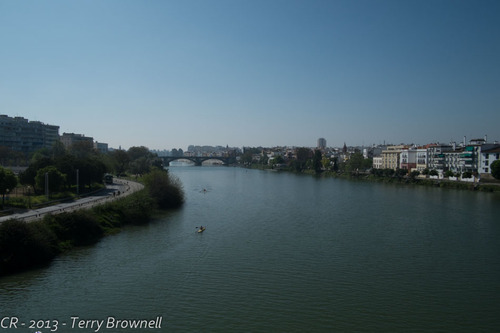
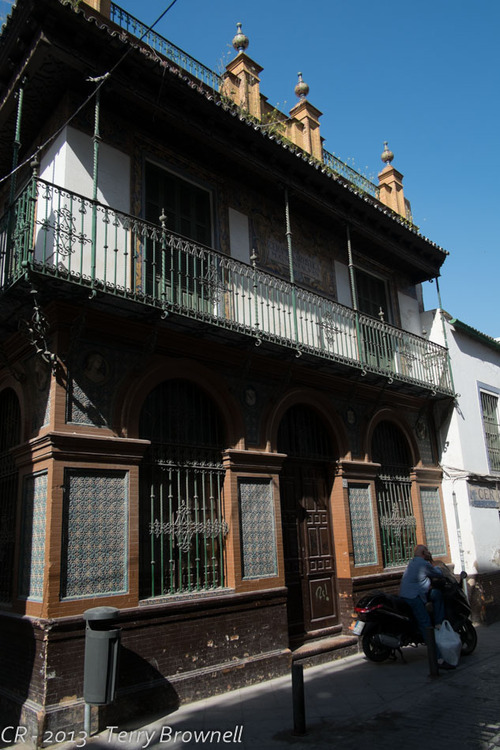
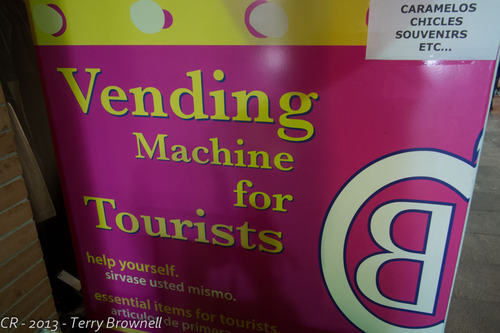
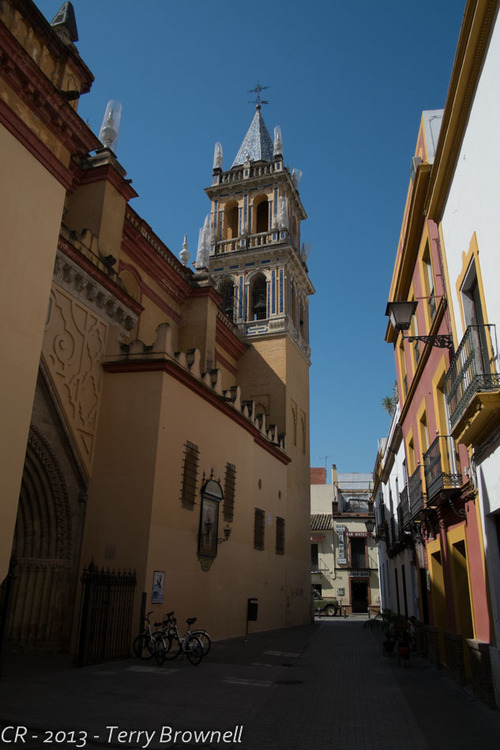
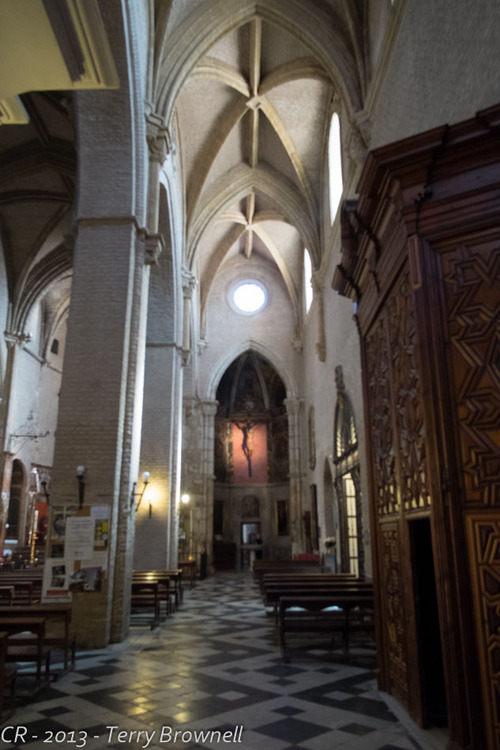
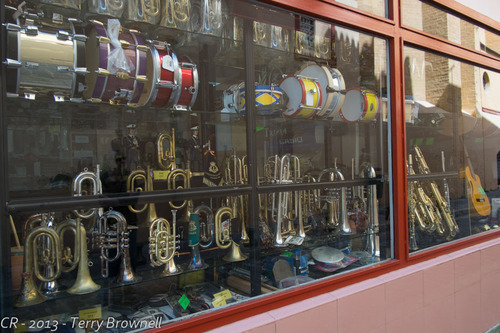
Our main goal for the day was the fairgrounds and a visit to the Feria de Abril, Sevilla’s famous celebration of the Andalusian horse culture. Founded around 1847 as a livestock and agricultural gathering, over time it has turned more into a giant social event. During the day, an endless stream of riders and carriages circle in processions, up and down streets lined with private tents, casetas in the local lingo, sponsored by families, companies and civic/professional groups as places for parties that go on into the evening. All the riders and drivers sport traditional equestrian wear, producing a genuine feast for the eyes. The tents are very festive, made from boldly striped fabric and each street is covered by a mesh of paper lanterns. Hundreds of women of all ages, from grandmas to babies in prams stroll around in flamenco wear, cooling themselves with beautiful fans. We spent a few hours taking photos and just wandering up and down the streets finally giving in to the heat and heading back across the river in search of an iced coffee and some shade.
Again, so many pictures that I’ve created a gallery via this link -
Fería de Abril
But here’s one to pique your interest.
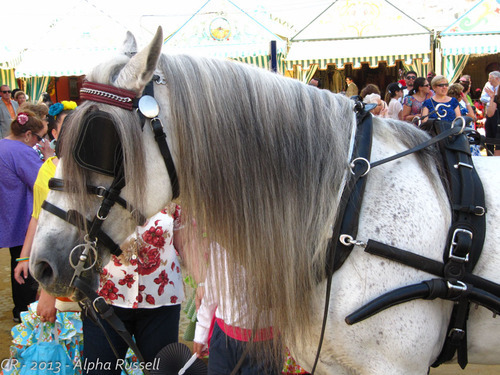
Following a recommendation from our Frommer’s Guide, we crossed the river and walked through the Triana district, home to Sevilla’s ceramic tile industry. An early flotilla of sculls and racing canoes was out on the river, gliding through the early morning light. Each day we’ve been here, we’ve seen people out either peacefully plying the smooth water or really putting themselves into a quick transit. I’m always so envious, and seeing them makes me wish that was something we could partake in. But given where we live, it’s not to be.
Our book suggested that some of the tile workshops would be open, none were but it was a nice walk and many of the building fronts were decorated in the tile work we’ve come to love. We made a quick stop in the Capillia de los Marineros, the Sailor’s Chapel, built between 1759 and 1815 and the last stop for sailors heading out across the Atlantic for the New World during the height of Spain’s colonization. The Virgin of Hope graces the main altar and a very beautiful altar with a highly detailed depiction of Christ and the Cross graces a side chapel. An elderly woman, in for morning prayers motioned me over to make sure that I would not leave without seeing it.
The Iglesia de Santa Ana was just up the street so we stopped by, paying a bargain price of 3 € for entry and receiving a nice laminated guide in English. The church was founded in 1264 by King Alfonso X after he had finished re-claiming Sevilla from the Moors. He named it for Saint Anne, the mother of the Virgin and in thanks for her intercession in curing him of a plague that hit the city around that time. It was a nice church, but what made our stop special was Manuel, the church docent who asked us if we’d like a personal tour of the crypt. Gathering up an Austrian couple, the only other visitors, he led us to a door behind a side chapel and down a windy set of stairs into the very foundation of the church, down where the brick work dated to the original construction on the 13th century. He was very proud and unusually tolerant of our meager Spanish, taking the time to explain all the pieces of ritual silver, much of it made from material brought back from Pizarro’s conquering of the Incas. He stopped at each case, giving us the details and stories behind the items, most of which dated to the 16th century. In a side alcove we stopped to look at a beautifully carved bust of Saint Ursula, home a a fragment of her skull and dating to the late 1300s.
As we got to know him, we talked a bit about where we were from and our village’s patron, San Ysidro and the old church around the corner from our home. It turned out that Manuel was a retired engineer from Siemens and he was most excited to learn that I was retired from Intel. Brothers in technology as it were. After the crypt he walked with us, fleshing out the details about the other chapels, the altar and the organ which he was sad to report that no longer worked due to the lack of a craftsman with the skills to repair it. We enjoyed his time so much that I offered a 5€ donation in gratitude for his time. Manuel, much like that great border agent mentioned in a past blog is one of the reasons we love to travel – meeting real characters, living life with some elan and always interested in developing a momentary relationship with people like us. Being able to communicate makes having a bit of the language so nice for both sides of the equation. We left after much hand shaking and “mucho gustos” and went off for a cup of coffee at a tiny neighborhood cafe that was in fact, not a Starbucks. The coffee shop we found was located in the San Jacinto neighborhood, a genuine working class area, nicer that the Alameda we visited last night, but not nearly as fancy as the more touristy Centro district where we are staying. We sat under an umbrella, drinking a couple of Americanos enjoying regular life going on around us.







Our main goal for the day was the fairgrounds and a visit to the Feria de Abril, Sevilla’s famous celebration of the Andalusian horse culture. Founded around 1847 as a livestock and agricultural gathering, over time it has turned more into a giant social event. During the day, an endless stream of riders and carriages circle in processions, up and down streets lined with private tents, casetas in the local lingo, sponsored by families, companies and civic/professional groups as places for parties that go on into the evening. All the riders and drivers sport traditional equestrian wear, producing a genuine feast for the eyes. The tents are very festive, made from boldly striped fabric and each street is covered by a mesh of paper lanterns. Hundreds of women of all ages, from grandmas to babies in prams stroll around in flamenco wear, cooling themselves with beautiful fans. We spent a few hours taking photos and just wandering up and down the streets finally giving in to the heat and heading back across the river in search of an iced coffee and some shade.
Again, so many pictures that I’ve created a gallery via this link -
Fería de Abril
But here’s one to pique your interest.




Comments